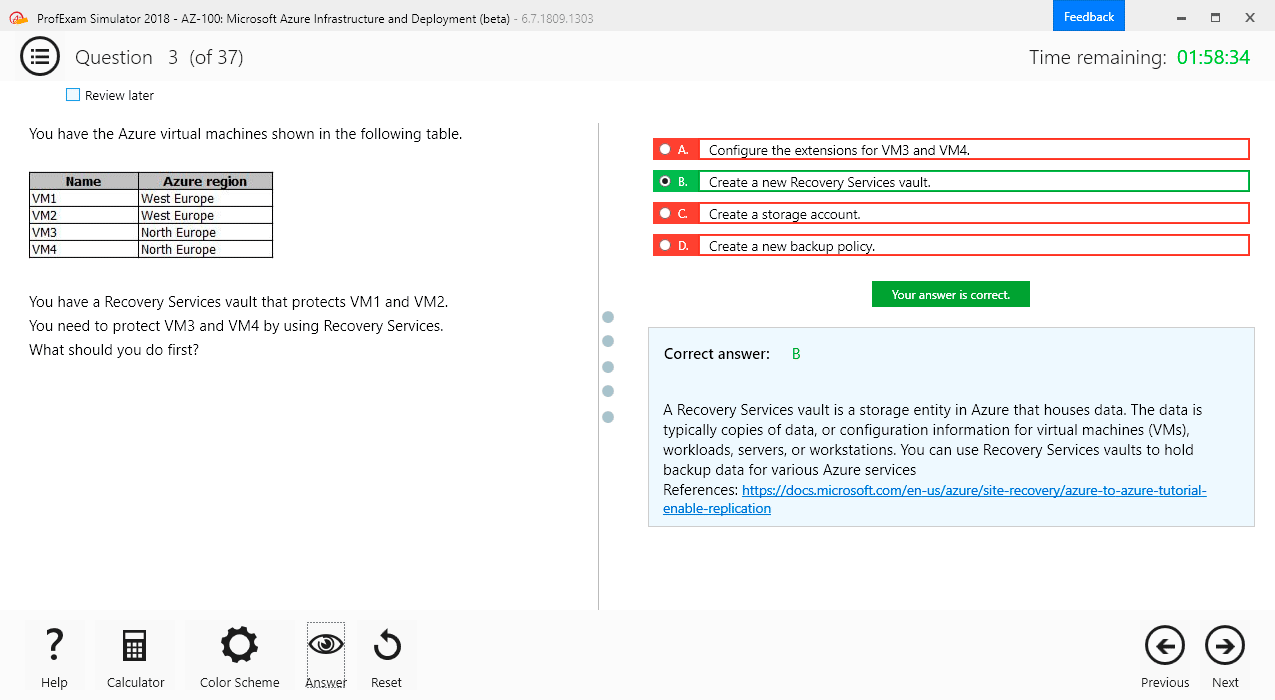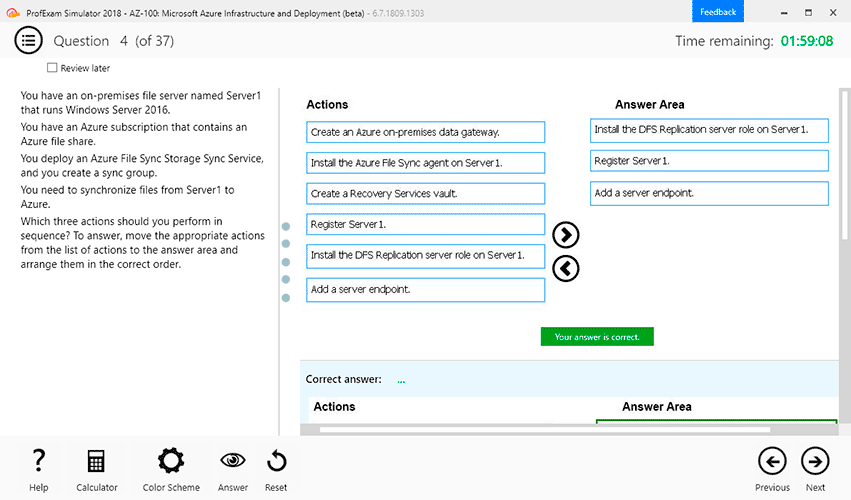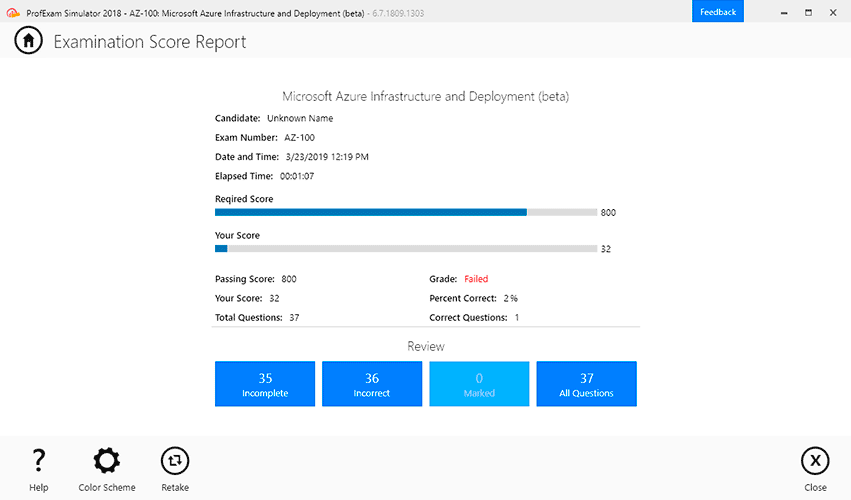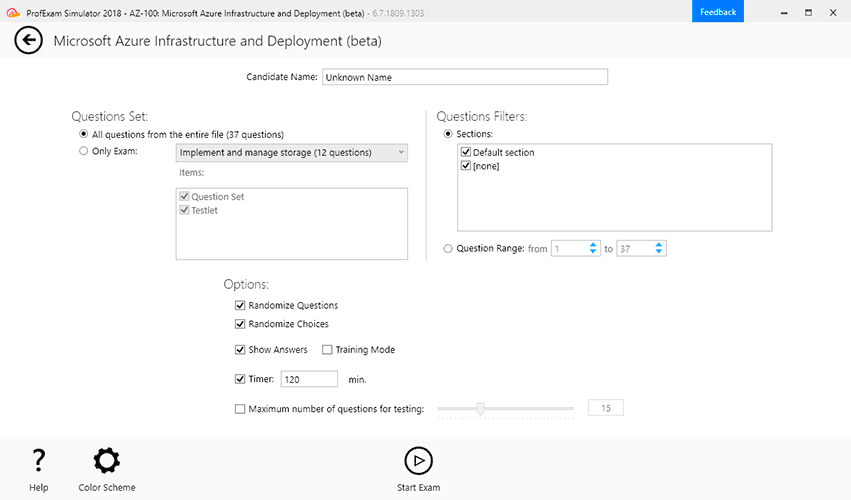File Info
| Exam | IBM Storage Technical V1 |
| Number | C9020-668 |
| File Name | IBM.C9020-668.PracticeTest.2018-10-12.67q.vcex |
| Size | 69 KB |
| Posted | Oct 12, 2018 |
| Download | IBM.C9020-668.PracticeTest.2018-10-12.67q.vcex |
How to open VCEX & EXAM Files?
Files with VCEX & EXAM extensions can be opened by ProfExam Simulator.
Coupon: MASTEREXAM
With discount: 20%





Demo Questions
Question 1
A customer needs to exchange encrypted data cartridges with another company. A competitor offers a solution that encrypts the data with static keys loaded the tape drives. IBM proposes IBM TS1150 tape drives using the built-in encryption feature.
Which competitive advantage does the IBM TS1150 solution provide?
- It achieves better throughput by encrypting and compressing data at the same time.
- It stores keys in the drive that can then be exported to partners in a secure format.
- It compresses the data before encrypting to achieve a better compression ratio.
- it writes a unique encrypted data key on the cartridge using public/private key pairs.
Correct answer: D
Explanation:
How the encryption key server processes encryption keys In system-managed and library-managed tape encryption, unencrypted data (clear text) is sent to the tape drive (TS1150 Tape Drive, TS1140 Tape Drive, TS1130 Tape Drive or TS1120 Tape Drive), and converted to ciphertext using a symmetric 256-bit AES Data Key (DK) generated by the encryption key server. The ciphertext is then written to tape. The encryption key server uses a single, unique Data Key for each Enterprise Tape Cartridge. This Data Key is also encrypted, or wrapped, by the encryption key server using the public key from an asymmetric Key Encrypting Key (KEK) pair. This process creates an Externally Encrypted Data Key (EEDK). The EEDK is written to the cartridge memory and to three additional places on the tape media in the cartridge. The tape cartridge now holds both the encrypted data and the means to decrypt it for anyone holding the private part of the KEK pair. The DK may also be wrapped a second time using the public key of another party to create an additional EEDK. Both EEDKs can be stored on the tape cartridge. In this way, the tape cartridge can be shipped to a business partner holding the corresponding private key. That private key would allow the DK to be unwrapped and the tape decrypted by the business partner. References: https://www.ibm.com/support/knowledgecenter/en/STFS69_3.3.0/ts7740_encryption_keys.html How the encryption key server processes encryption keys
In system-managed and library-managed tape encryption, unencrypted data (clear text) is sent to the tape drive (TS1150 Tape Drive, TS1140 Tape Drive, TS1130 Tape Drive or TS1120 Tape Drive), and converted to ciphertext using a symmetric 256-bit AES Data Key (DK) generated by the encryption key server. The ciphertext is then written to tape. The encryption key server uses a single, unique Data Key for each Enterprise Tape Cartridge. This Data Key is also encrypted, or wrapped, by the encryption key server using the public key from an asymmetric Key Encrypting Key (KEK) pair. This process creates an Externally Encrypted Data Key (EEDK). The EEDK is written to the cartridge memory and to three additional places on the tape media in the cartridge. The tape cartridge now holds both the encrypted data and the means to decrypt it for anyone holding the private part of the KEK pair.
The DK may also be wrapped a second time using the public key of another party to create an additional EEDK. Both EEDKs can be stored on the tape cartridge. In this way, the tape cartridge can be shipped to a business partner holding the corresponding private key. That private key would allow the DK to be unwrapped and the tape decrypted by the business partner.
References: https://www.ibm.com/support/knowledgecenter/en/STFS69_3.3.0/ts7740_encryption_keys.html
Question 2
A customer wants to improve storage efficiency within a data center. The customer requires a low latency storage system that has a highly parallel architecture and comprehensive data reduction with pattern removal.
Which system should the technical specialist propose?
- IBM DS8886 HPFE
- IBM FlashSystem A9000R
- IBM FlashSystem V9000
- IBM XIV with compression
Correct answer: C
Explanation:
IBM FlashSystem A9000 is a highly parallel, all-flash storage solution for cloud-scale businesses:Harness the performance of highly parallel architecture and IBM FlashCore technology in one innovative system Optimize storage economics with pattern removal, deduplication, and compression Incorrect Answers:B: IBM FlashSystem(R) A9000R is a grid-scale, all-flash storage platform.References: https://www-01.ibm.com/common/ssi/rep_ca/7/872/ENUSAG16-0087/ENUSAG16-0087.PDF IBM FlashSystem A9000 is a highly parallel, all-flash storage solution for cloud-scale businesses:
- Harness the performance of highly parallel architecture and IBM FlashCore technology in one innovative system
- Optimize storage economics with pattern removal, deduplication, and compression
Incorrect Answers:
B: IBM FlashSystem(R) A9000R is a grid-scale, all-flash storage platform.
References: https://www-01.ibm.com/common/ssi/rep_ca/7/872/ENUSAG16-0087/ENUSAG16-0087.PDF
Question 3
Which solution provides virtualization, consolidation, and automation for a cloud deployment?
- IBM XIV with IBM Spectrum Protect
- IBM FlashSystem 900
- IBM Virtual Storage Center
- IBM Spectrum Accelerate
Correct answer: C
Explanation:
IBM Virtual Storage Center is a storage virtualization platform and a storage management solution for cloud-based and software-defined storage. Virtual Storage Center enables organizations to monitor, automate and analyze storage. Incorrect Answers:B: IBM FlashSystem 900 all-flash storage arrays accelerate applications in mission-critical environments.D: Use IBM Spectrum Accelerate to build a flexible, cost-effective cloud environment: deploy on any x86 server.References: http://www-03.ibm.com/software/products/en/ibm-virtual-storage-center IBM Virtual Storage Center is a storage virtualization platform and a storage management solution for cloud-based and software-defined storage. Virtual Storage Center enables organizations to monitor, automate and analyze storage.
Incorrect Answers:
B: IBM FlashSystem 900 all-flash storage arrays accelerate applications in mission-critical environments.
D: Use IBM Spectrum Accelerate to build a flexible, cost-effective cloud environment: deploy on any x86 server.
References: http://www-03.ibm.com/software/products/en/ibm-virtual-storage-center
Question 4
A customer looking for an all-flash solution is evaluating IBM products. The primary concern for the customer is rapid growth of its database environment.
Which IBM flash solution should the specialist recommend to control capacity utilization?
- IBM XIV Gen3 with SSD
- IBM DS8886 HPFE
- IBM Flashsystem A9000
- IBM FlashSystem 900
Correct answer: D
Explanation:
IBM FlashSystem 900 is designed to accelerate the applications that drive business – like those using an Oracle Database. IBM FlashSystem 900 can scale usable capacity from as low as 2 TB to as much as 57 TB in a single system. FlashSystem 900 delivers Tier 0 top application performance with up to 1.1 million 100% random read IOPS and 600,000 100% random write IOPS. References: https://www.ibm.com/us-en/marketplace/flash-storage IBM FlashSystem 900 is designed to accelerate the applications that drive business – like those using an Oracle Database.
IBM FlashSystem 900 can scale usable capacity from as low as 2 TB to as much as 57 TB in a single system.
FlashSystem 900 delivers Tier 0 top application performance with up to 1.1 million 100% random read IOPS and 600,000 100% random write IOPS.
References: https://www.ibm.com/us-en/marketplace/flash-storage
Question 5
A customer is looking to take advantage of data reduction capabilities of the IBM SAN Volume Controller.
Which tool should the technical specialist use?
- Capacity Magic
- Comprestimator
- Disk Magic
- IBM Storage Tier Advisor Tool
Correct answer: A
Explanation:
Capacity Magic calculates the effective storage capacity of your current and future IBM Disk Subsystems through an easy-to-use graphical dialog. This tool is available to IBM Business Partners. Incorrect Answers:B: The Comprestimator utility uses advanced mathematical and statistical algorithms to perform the sampling and analysis process in a very short and efficient way. The utility also displays its accuracy level by showing the maximum error range of the results achieved based on the formulas it uses. The utility runs on a host that has access to the devices that will be analyzed, and performs only read operations so it has no effect whatsoever on the data stored on the device.C: Disk Magic provides you with a thorough understanding of your current Disk Subsystem performance and enables you to make better purchase and configuration decisions.D: The IBM Storage Tier Advisor Tool predicts whether the addition of Solid State Drive (SSD), Enterprise Drive and Nearline Drive capacity in conjunction with the Easy Tier function.References: https://www.codeweavers.com/compatibility/crossover/ibm-capacity-magic Capacity Magic calculates the effective storage capacity of your current and future IBM Disk Subsystems through an easy-to-use graphical dialog. This tool is available to IBM Business Partners.
Incorrect Answers:
B: The Comprestimator utility uses advanced mathematical and statistical algorithms to perform the sampling and analysis process in a very short and efficient way. The utility also displays its accuracy level by showing the maximum error range of the results achieved based on the formulas it uses. The utility runs on a host that has access to the devices that will be analyzed, and performs only read operations so it has no effect whatsoever on the data stored on the device.
C: Disk Magic provides you with a thorough understanding of your current Disk Subsystem performance and enables you to make better purchase and configuration decisions.
D: The IBM Storage Tier Advisor Tool predicts whether the addition of Solid State Drive (SSD), Enterprise Drive and Nearline Drive capacity in conjunction with the Easy Tier function.
References: https://www.codeweavers.com/compatibility/crossover/ibm-capacity-magic
Question 6
A customer needs to import and export volumes between IBM Spectrum Virtualize clusters that are geographically separated.
How can this be accomplished?
- Create image mode volumes
- Snapshots with Transparent Cloud Tiering
- Implement IBM Spectrum Archive
- Utilize tiering-to-tape media
Correct answer: B
Explanation:
Transparent cloud tiering is a licensed function that enables volume data to be copied and transferred to cloud storage. The system supports creating connections to cloud service providers to store copies of volume data in private or public cloud storage. With transparent cloud tiering, administrators can move older data to cloud storage to free up capacity on the system. Point-in-time snapshots of data can be created on the system and then copied and stored on the cloud storage. References: https://www.ibm.com/support/knowledgecenter/en/STVLF4_7.8.1/spectrum.virtualize.781.doc/svc_icoverviewtranparentcltier.html Transparent cloud tiering is a licensed function that enables volume data to be copied and transferred to cloud storage. The system supports creating connections to cloud service providers to store copies of volume data in private or public cloud storage.
With transparent cloud tiering, administrators can move older data to cloud storage to free up capacity on the system. Point-in-time snapshots of data can be created on the system and then copied and stored on the cloud storage.
References: https://www.ibm.com/support/knowledgecenter/en/STVLF4_7.8.1/spectrum.virtualize.781.doc/svc_icoverviewtranparentcltier.html
Question 7
A customer has existing SAP HANA production nodes connected to an IBM Elastic Storage Server (ESS). The customer needs to scale out additional ESS nodes to maintain the high I/O throughput requirement.
Which type of nodes should be proposed?
- Storage nodes with SAS drives
- Storage nodes with SSD drives
- Protocol nodes with SAS drives
- Protocol nodes with SSD drives
Correct answer: B
Explanation:
A scale-out NAS system is comprised of multiple NAS storage nodes with internal or external storage. Each NAS storage node represents the same file systems to user applications. Data is stored across all NAS storage nodes, and adding capacity can be achieved by adding more storage nodes. References: https://www-03.ibm.com/systems/storage/spectrum/scale/scale-out-nas.html A scale-out NAS system is comprised of multiple NAS storage nodes with internal or external storage. Each NAS storage node represents the same file systems to user applications. Data is stored across all NAS storage nodes, and adding capacity can be achieved by adding more storage nodes.
References: https://www-03.ibm.com/systems/storage/spectrum/scale/scale-out-nas.html
Question 8
An IBM DS8886 customer wishes to replicate data from the primary data center to a new secondary data center 310 miles (500km) away while maintaining a low recovery point objective.
Which offering should the technical specialist recommend?
- SnapMirror
- Metro Mirror
- Global Mirror
- FlashCopy
Correct answer: C
Explanation:
Global Mirror is a long-distance remote copy function across two sites using asynchronous technology. Global Mirror processing is designed to provide support for virtually unlimited distance between the local and remote sites, with the distance typically limited only by the capabilities of the network and the channel extension technology. Incorrect Answers:B: Metro Mirror provides real-time mirroring of logical volumes between two DS8000 storage units that can be located up to 300 km from each other.References: https://www.ibm.com/support/knowledgecenter/en/HW213_7.1.0/com.ibm.storage.ssic.help.doc/f2c_copysgintro_1xiohq.html Global Mirror is a long-distance remote copy function across two sites using asynchronous technology. Global Mirror processing is designed to provide support for virtually unlimited distance between the local and remote sites, with the distance typically limited only by the capabilities of the network and the channel extension technology.
Incorrect Answers:
B: Metro Mirror provides real-time mirroring of logical volumes between two DS8000 storage units that can be located up to 300 km from each other.
References: https://www.ibm.com/support/knowledgecenter/en/HW213_7.1.0/com.ibm.storage.ssic.help.doc/f2c_copysgintro_1xiohq.html
Question 9
A customer has existing fiber attached storage that has reached the end of life. The customer wants a scalable solution that is easy to manage and integrates with VMware. The customer prefers an IBM A9000R based solution, but is concerned about migrating the virtual machines and ESX boot volumes.
Which explanation addresses the customer’s concern?
- Use VMware Storage vMotion to migrate virtual machines and boot volumes.
- IBM A9000R has both a vCenter and VAAI plug in.
- Use IBM Spectrum Control to virtualize and move existing storage to the new IBM A9000R.
- IBM A9000R has a built in capability to copy the existing data.
Correct answer: A
Explanation:
VMware VMotion: Allows the live migration of running VMs from one physical server to another, one data store to another, or both. This migration has zero downtime, continuous service availability, and complete transaction integrity.References: http://www.redbooks.ibm.com/redpapers/pdfs/redp5425.pdfUsing the IBM Spectrum Accelerate Family in VMware Environments, page 15 VMware VMotion: Allows the live migration of running VMs from one physical server to another, one data store to another, or both. This migration has zero downtime, continuous service availability, and complete transaction integrity.
References: http://www.redbooks.ibm.com/redpapers/pdfs/redp5425.pdf
Using the IBM Spectrum Accelerate Family in VMware Environments, page 15
Question 10
A customer is purchasing an IBM 3952 Tape Frame for an IBM TS3500 Tape Library.
In which resource can you find the customer’s detailed worksheets to complete the installation?
- IBM 3952 Tape System SAPR Guide
- IBM TS3500 Tape Library with System z Attachment Guide
- IBM 3952 Introduction and Planning Guide
- IBM TS3500 Introduction and Planning Guide
Correct answer: A

